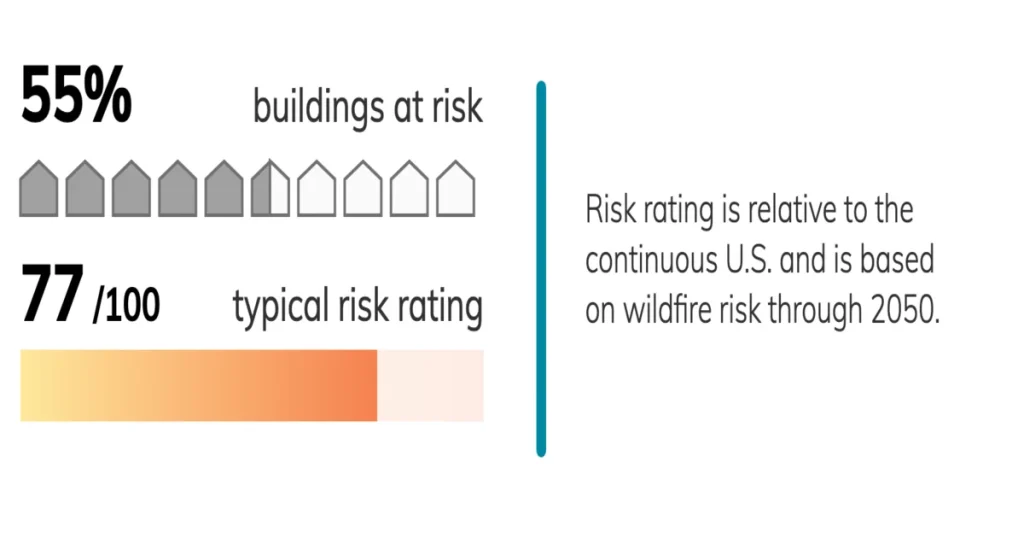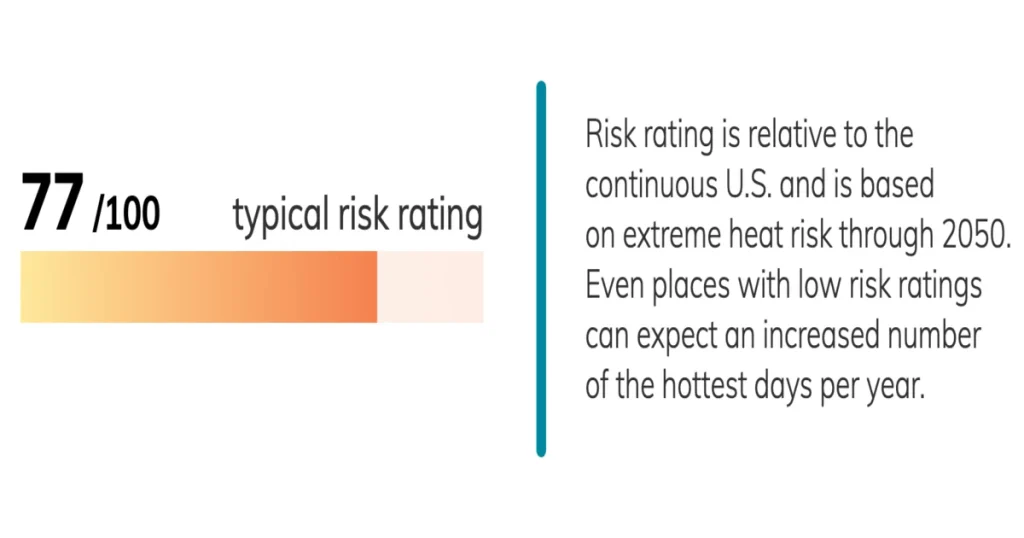Living in the charming city of Prescott, Arizona, has its fair share of perks: from its rich history to its scenic beauty. However, like any other region, it’s not exempt from the forces of nature. Recent years have shown us that climate risks and hazards are no longer abstract terms; they’re real, imminent, and demand our attention.

This comprehensive guide aims to provide an in-depth look at various climate risks and hazards that the Prescott community should be aware of. Let’s delve into the world of wildfires, flash floods, heatwaves, and other climate challenges we face, and learn how we can mitigate these risks for a safer future.
A Snapshot of Prescott’s Climate
Prescott enjoys a relatively mild climate compared to other parts of Arizona. However, it’s crucial to understand that no area is isolated from the changing global climate. Over the past couple of decades, we’ve seen slight yet significant changes in temperature and precipitation patterns here in Prescott.
Studies indicate that the Southwest, including Arizona, is getting warmer and will continue to do so. These aren’t just numbers on a page; they are changes that could profoundly impact our way of life in Prescott, from water scarcity to increased wildfire risks.
The National Climate Assessment provides an excellent resource for understanding these regional changes in detail.
Understanding Climate Risk
So, what exactly is climate risk? In simple terms, it’s the possibility that climate-related events could lead to adverse outcomes for a community, environment, or even the economy. It’s not just about knowing that a heatwave or a flood might occur; it’s about understanding the ‘ripple effect’ those events could have.
For example, a prolonged heatwave doesn’t just mean uncomfortable temperatures. It also has the potential to strain our local energy grid, impact public health, and even cause water shortages. Knowing the risks allows us to better prepare for them, both as individuals and as a community.
Resources like FEMA’s Climate Change Adaptation Resource Center can offer valuable insights into understanding and managing climate risks.
The Science Behind Climate Hazards
Climate hazards are extreme weather events or patterns that are worsened by the effects of climate change. When we talk about the science behind these hazards, we often refer to climate models and scientific studies that try to predict their frequency and severity. These models are essential tools for scientists and policymakers alike.
One common misconception is that climate models are merely speculative. On the contrary, these models are highly sophisticated and based on an array of variables, from greenhouse gas concentrations to ocean temperatures. They help us understand what the future might look like under different scenarios.

The Intergovernmental Panel on Climate Change (IPCC) provides invaluable information on how these models are created and used.
Wildfires
Anyone who’s been in Prescott for a decent length of time knows that wildfires are not a matter of if, but when. The dry climate, coupled with periods of drought, creates ideal conditions for wildfires to break out. As the planet continues to warm, these conditions are only expected to worsen.
But it’s not all doom and gloom; there are preventative measures that can mitigate the risk. From creating defensible spaces around your property to adhering to fire bans, there are ways to live in harmony with the land. The National Fire Protection Association offers a wealth of information on how homeowners can protect their property.
Heatwaves
Did you know that heatwaves are among the deadliest natural disasters? According to the Centers for Disease Control and Prevention, more people die from heat-related illnesses in the U.S. each year than from any other weather-related cause. In Prescott, the frequency and intensity of heatwaves have been rising steadily.
The heat is especially hard on vulnerable populations like the elderly, the very young, and those with preexisting health conditions. Community centers, churches, and other places often transform into cooling centers during extreme heat events. Keep an eye out for such initiatives, as they can be life-saving.
Drought Conditions
Droughts are another harsh reality in Prescott and the greater Arizona area. These prolonged periods of less-than-average rainfall can severely impact water resources. Reservoir levels dip, groundwater depletes, and before you know it, water restrictions are in place.
But the impact doesn’t stop there. Drought conditions can have significant repercussions on agriculture, including crop failure and livestock stress. One silver lining is that public awareness about water conservation has been growing, and there are now numerous water-saving techniques promoted by organizations like the Environmental Protection Agency.
Flash Floods
Contrary to what some might think, droughts and flash floods can coexist. Because the ground is so dry, it’s less able to absorb sudden onslaughts of rain, which can lead to flash floods. Areas around creeks, streams, and poor drainage systems are particularly susceptible.
So, what can be done? Simple steps like staying informed about local weather forecasts and avoiding flood-prone areas during heavy rainfall can go a long way. Websites like the National Weather Service offer real-time updates and safety tips on flash floods.
Wind and Dust Storms
Wind and dust storms might not be as immediately threatening as wildfires or floods, but they come with their own set of challenges. Strong winds can result in power outages, falling trees, and other dangers. Dust storms, on the other hand, significantly reduce visibility and impact air quality.
Driving during a dust storm can be especially hazardous. The Arizona Department of Transportation recommends pulling over and turning off all vehicle lights to avoid collisions. Air quality can also plummet during these storms, exacerbating asthma and other respiratory conditions. Websites like AirNow offer real-time air quality assessments, helping residents make informed decisions.

Snow and Winter Storms
While Prescott isn’t known for extreme winter weather, we do get our fair share of snow and winter storms. And if you’re thinking that climate change means less snow, think again. Climate change can lead to unpredictable weather patterns, which may include severe winter storms.
Aside from the obvious travel complications, heavy snowfall can result in power outages, sometimes leaving residents without heat. Preparing an emergency kit and keeping extra blankets can make all the difference. For real-time winter weather forecasts, you can rely on websites like The Weather Channel.
Landslides and Soil Erosion
Prescott’s varied terrain—though beautiful—also makes certain areas prone to landslides, particularly during heavy rain. Soil erosion is a related concern, often exacerbated by human activities like deforestation and poorly planned construction.
Preventing these disasters is a community effort. Through responsible land use, reforestation, and the creation of barriers, landslides can be mitigated. Educational resources from the U.S. Geological Survey offer insights into identifying risk areas and taking preventive action.
Climate Impact on Local Flora and Fauna
The changing climate doesn’t just affect us humans; it impacts the entire ecosystem. Various species of flora and fauna in Prescott are struggling to adapt to rapidly changing conditions.
- Endangered species face further risk due to loss of habitat and food scarcity.
- Invasive species could potentially destabilize local ecosystems.
- Seasonal changes may disrupt the natural cycles of native plants and animals.
Conservation initiatives aim to mitigate these impacts. Organizations like The Nature Conservancy offer ways for local residents to get involved.
Infrastructure Vulnerabilities
Infrastructure isn’t just about roads and bridges; it also encompasses our water supply, electrical grids, and public buildings. As climate change amplifies the risks of extreme weather events, our infrastructure may come under significant strain.
Even our hospitals and schools need to be evaluated for their resilience to climate risks. For instance, are they equipped to function during extreme heat, or prepared for the challenges that come with flooding? The American Society of Civil Engineers has published guidelines on how to make infrastructure more resilient against climate change.
Economic Implications
Let’s face it, climate risks and hazards don’t just threaten our well-being; they also pose a considerable economic burden. From property damage to increased healthcare costs and even job losses, the economic ramifications can be extensive.
A recent study by The National Bureau of Economic Research suggests that unmitigated climate change could reduce global GDP by more than 20% by 2100. While those figures are global, the implications are local. Every community, including Prescott, would feel the pinch.
Policy Responses and Local Initiatives
If we’re going to combat climate risks effectively, we need strong policy responses at the local, state, and federal levels. Fortunately, there are a few initiatives in place that aim to make Prescott more resilient against climate risks.
For instance, local governments and non-profits often collaborate on programs focused on water conservation, sustainable agriculture, and disaster preparedness. It’s a multidisciplinary approach, involving urban planners, scientists, and community activists. The U.S. Climate Resilience Toolkit offers resources and best practices for communities looking to formulate robust climate action plans.
Community Participation: What Can You Do?
Change starts at home, they say, and never has this been truer than in the context of climate change. There are numerous ways in which you, as a Prescott resident, can contribute to climate resilience.

- Participate in community clean-up events
- Advocate for green initiatives in your neighborhood
- Educate others about the importance of climate resilience
You don’t need to be a policymaker or a scientist to make a difference. Organizations like Climate Reality offer various avenues for community members to get involved.
FAQs:
In this section, we will be delving into some of the most common inquiries and curiosities that surround our topic.
What are the most common climate risks in Prescott?
Wildfires, heatwaves, and flash floods are among the most frequent and severe climate risks in Prescott.
How does climate change exacerbate these risks?
Climate change can lead to increased temperatures, altered precipitation patterns, and more extreme weather events, thereby increasing the frequency and severity of these risks.
Are there resources available for residents to learn more?
Yes, websites like the National Climate Assessment and FEMA’s Climate Change Adaptation Resource Center offer detailed information on climate risks and how to prepare for them.
Conclusion: Climate risks and hazards in Prescott
We’ve covered a lot of ground in this article, examining the various climate risks and hazards in Prescott, Arizona. It’s clear that while Prescott has a lot to offer, we must also confront the environmental challenges that come with living here.
Climate change isn’t just a global issue; it’s a local one too. By staying informed, making smart choices, and participating in community efforts, we can make Prescott a safer, more resilient place for everyone.



Leave a Comment
You must be logged in to post a comment.